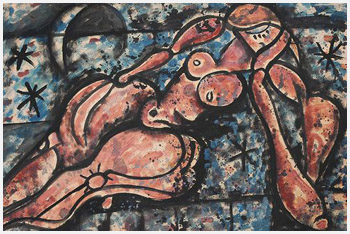EDUCATION
Basically self-taught. At the age of nine, learned
drawing from a local drawing teacher. 1933 Diploma,
City College, Calcutta University. 1937-38 Graduated
in Law and started legal practice. Visited the studios
of Abanindranath Tagore, Jamini Prakash Gangooly, Atul
Bose, received lessons and encouragement from them.
More than two years he worked in the studio of Hemen
Majumdar, where he completed his apprenticeship of portrait
painting.
EXHIBITIONS
1957 Artistry House, Calcutta. 1961 Hofstra College,
New York. 1963 Gallery Everest, Calcutta. Had group
exhb. in Tokyo, Brussels, New Castle, New York, Sydney,
Perth. Gallery Chemould, Bombay. 1993 Retrospective,
Birla Academy of Art and Culture, Calcutta. 2003 Manifestations,
organised by Delhi Art Gallery, World Trade Center,
Mumbai and Delhi Art Gallery, New Delhi. 2004 Manifestations
II, organised by Delhi Art Gallery, Jehangir Art Gallery,
Mumbai and Delhi Art Gallery, New Delhi. 2005 Manifestations
III, organised by Delhi Art Gallery, Nehru Center, Mumbai
and Lalit Kala Akademi, New Delhi.
COLLECTION
Lalit Kala Academy, New Delhi. National Gallery of
Modern Art, New Delhi. Birla Academy of Arts & Culture,
Calcutta. Chandigarh Musuem. Library of Congress, USA.
New York Public Library. Bradford Museum, England. Administrative
Block of the Jadavpur University, Calcutta. Victoria
Memorial Hall, Calcutta. Delhi Art Gallery, New Delhi.
AWARDS
- 1945 Academy Award, Calcutta.
STYLE
Sunil Madhab Sen in his search for a modernist language
in art, has tried out both Western and Indigenous artistic
modes to arrive at a personal idiom. A simplified serene
beauty, that his art explores, is an outcome of the
inwardness of his consciousness. His passage from academic
naturalism to Indian folk tradition via European cubistic
and expressionistic features and a proper synthesis
of all these modes unfolded to him a process of Indian
modernity.

back |



